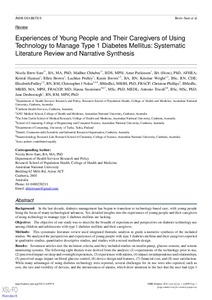Experiences of young people and their caregivers of using technology to manage type 1 diabetes mellitus: Systematic literature review and narrative synthesis
Brew-Sam Nicola; Chhabra Madhur; Parkinson Anne; Hannan Kristal; Brown Ellen; Pedley Lachlan; Brown Karen; Wright Kristine; Pedley Elizabeth; Nolan Christopher J.; Phillips Christine; Suominen Hanna; Tricoli Antonio; Desborough Jane
https://urn.fi/URN:NBN:fi-fe2022091258796
Tiivistelmä
Background:
In the last decade, diabetes management has begun to transition to technology-based care, with young people being the focus of many technological advances. Yet, detailed insights into the experiences of young people and their caregivers of using technology to manage type 1 diabetes mellitus are lacking.
Objective:
The objective of our study was to describe the breadth of experiences and perspectives on diabetes technology use among children and adolescents with type 1 diabetes mellitus and their caregivers.
Methods:
This systematic literature review used integrated thematic analysis to guide a narrative synthesis of the included studies. We analyzed the perspectives and experiences of young people with type 1 diabetes mellitus and their caregivers reported in qualitative studies, quantitative descriptive studies, and studies with a mixed methods design.
Results:
Seventeen articles met the inclusion criteria, and they included studies on insulin pump, glucose sensors, and remote monitoring systems. The following eight themes were derived from the analysis: (1) expectations of the technology prior to use, (2) perceived impact on sleep and overnight experiences, (3) experiences with alarms, (4) impact on independence and relationships, (5) perceived usage impact on blood glucose control, (6) device design and features, (7) financial cost, and (8) user satisfaction. While many advantages of using diabetes technology were reported, several challenges for its use were also reported, such as cost, the size and visibility of devices, and the intrusiveness of alarms, which drew attention to the fact that the user had type 1 diabetes mellitus. Continued use of diabetes technology was underpinned by its benefits outweighing its challenges, especially among younger people.
Conclusions:
Diabetes technologies have improved the quality of life of many young people with type 1 diabetes mellitus and their caregivers. Future design needs to consider the impact of these technologies on relationships between young people and their caregivers, and the impact of device features and characteristics such as size, ease of use, and cost.
Kokoelmat
- Rinnakkaistallenteet [27094]
